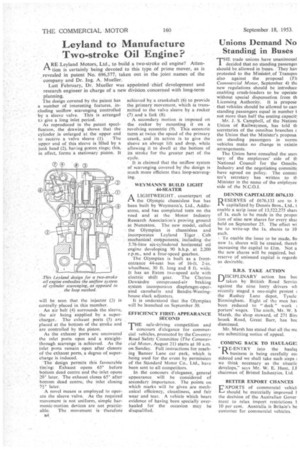Leyland to Manufacture Two-stroke Oil Engine?
Page 38

If you've noticed an error in this article please click here to report it so we can fix it.
J\ RE .Leyland Motors, Ltd., to build a two-stroke oil engine? Allention is certainly being devoted to this type of prime mover, as is revealed in patent No. 696,577, taken out in the. joint names of the
company. and Dr. Ing. A. Mueller. Last February, Dr. Mueller was appointed chief development and research engineer in charge of a new division concerned with long-term planning.
The design covered by the patent has a number of interesting features, in-eluding -uniflow scavenging controlled by a sleeve valve. This is arranged to -give a long inlet period.
As reproduced in the patent specification, the drawing shows that the cylinder is enlarged at. the upperend
• to receive a valve sleeve (1), • The .upper end of this sleeve is filled by a junk head (2), having piston. rings; this, in effect, forms a stationary piston. It
will be seen that the injector (3) is centrally placed in this member.
• An air belt (4) surrounds the sleeve, the air being supplied by a supercharger. The exhaust ports (5) arc placed at the bottom of the stroke and are controlled by the piston.
As the exhaust ports are uncovered the inlet ports open and a straightthrough scavenge is achieved. As the inlet ports remain open after closure of the exhaust ports, a degree of supercharge is induced.
The design permits this favourable timing: Exhaust opens 65° before bottom dead centre and the. inlet opens 20° later. The exhaust closes 65' after bottom dead centre, the inlet closing 71.° later.
A novel means is employed to operate the sleeve valve. As the required movement is not uniform, simple harmonic-motion devices are not practic
able. The movement is -therefore 13.4.
achieved by a crankshaft (6) to provide the Primary movement, which is transmitted to the valve sleeve by a rocker (7) and a link (8).
A secondary motion is imposed on the rocker by mounting it on a revolving eccentric (9). This eccentric turns at twice the speed of the primary crank, and its action is to give the sleeve an abrupt lift and drop, while allowing it to dwell at the bottom of its stroke for the greater part of • the cycle.
It is claimed that the uniflow system of scavenging covered by the design is much more efficient than loop-scavenging.
WEYMANN'S BUILD LIGHT 94-SEATER
;rt A LIGHTWEIGHT, counterpart of . the. Olympic chassisless bus has been built by Weyrnanifs, Ltd., Addlestone, and has completed tests on the road and at the Motor Industry Research Association's proving ground at Nuneaton. The new model, called the Olympian is chassisless and incorporates Leyland Tiger Cub mechanical coMporients,including the 5.76-litre six-cylindered horizontal oil engine developing 90 b.h.p. at 2,200 r.p.m., and a four-speed gearbox.
The Olympian is built as a frontentrance 44-seat bus of 16-fl. 2-in. wheelbase, 30 ft. long and 8 ft. wide. It has an Eaton two-speed axle with electric shift gear. The Clayton Dewandre compressed-air braking system incorporates diaphragm-operated camshafts and Bendix-Westinghouse slack adjusters.
It is understood that the Olympian will be launched on September 30.
EFFICIENCY FIRST: APPEARANCE SECOND
THE safe-driving competition and concours d'elegance for commercial vehicles, promoted by the Coventry .Road Safety Committee (The Commercial Motor, August 21) starts at 10 a.m. on Sunday. Full instructions for reaching Banner Lane car park, which is being used for the event by permission of the Standard Motor Co.. Ltd., have been sent to all competitors.
In the concours d'elegance, general appearance will be considered of secondary importance. The points on which marks will be given are mechanical efficiency, cleanliness, and fair wear and tear. A vehicle which bears evidence of having been specially overhauled for the occasion may be disqualified.




































































































